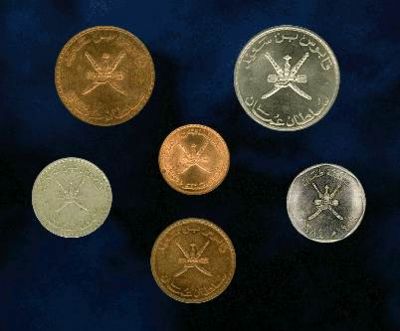阿曼里亞爾
出自 MBA智库百科(https://wiki.mbalib.com/)
阿曼里亞爾(Oman Riyal/Omani rial/ريال عماني (Arabic)原符號:RO. 標準符號:OMR)
目錄[隱藏] |
阿曼的貨幣為里亞爾,阿曼里亞爾可以自由兌換,與美元的匯率一直穩定在1 里亞爾換2.6美元。
阿曼里亞爾紙幣有:50, 20, 10, 5 和1阿曼瑞爾,還有500, 250, 200 及100 派沙。
硬幣的面值為: 2、5、10、25、50、100、250、500派沙
阿曼里亞爾的輔幣為派沙,1里亞爾=1000派沙
- ISO 4217 Code:OMR
- User(s):Oman
- Inflation:2%
- Source:The World Factbook, 2006 est.
- Pegged with:rial = 2.6008 U.S. dollars
- Subunit:1/1000 baisa
- Symbol:ر.ع.
- Coins:5, 10, 25, 50 baisa
- Banknotes :100, 200 baisa, ½, 1, 5, 10, 20, 50 rials
- Central bank:Central Bank of Oman
- Website:http://www.cbo-Oman.org
The rial (Arabic: ريال, ISO 4217 code OMR) is the currency of Oman. It is divided into 1000 baisa (also written baiza, Arabic: بيسة).
History
Before 1940, the Indian rupee and the Maria Theresa Thaler (known locally as the rial) were the main currencies circulating in Muscat and Oman, as the state was then known, with rupees circulating on the coast and Thaler in the interior. Maria Theresa Thaler were valued at 230 paisa, with 64 paisa equal to the rupee.[1]
In 1940, coins were introduced for use in Dhofar, followed, in 1946, by coins for use in Oman. Both coinages were denominated in baisa (equivalent to the paisa), with 200 baisa to the rial. The Indian rupee and, from 1959, the Gulf rupee continued to circulate.
In 1970, the rial Saidi (not to be confused with Saudi riyal) was made the currency of Oman. It was equal to the British pound and replaced the Gulf rupee at a rate of approximately 21 rupees to the rial. The new rial was subdivided into 1000 baisa. The rial Omani replaced the rial Saidi at par in 1973. The currency name was altered due to the regime change in 1970 and the subsequent change of the country's name.
Coins
In the 1890s, coins for 1⁄12 and ¼ anna (⅓ and 1 paisa) were minted specifically for use in Muscat and Oman.
In 1940, coins were issued for use in Dhofar in denominations of 10, 20 and 50 baisa. ½ rial coins were added in 1948, followed by 3 baisa in 1959. In 1946, 2, 5 and 20 baisa coins were introduced for use in Oman. These were followed, between 1959 and 1960, by 3 baisa, ½ and 1 rial coins.
In 1970, a coinage for all of Muscat and Oman was introduced. Denominations were 2, 5, 10, 25, 50 and 100 baisa. In 1975, new coins was issued with the country's name given as Oman. ¼ and ½ rial coins were introduced in 1980. Coins currently circulating are
- 5 baisa
- 10 baisa
- 25 baisa
- 50 baisa
- 100 baisa
- ¼ rial omani
- ½ rial omani
Banknotes
In 1970, banknotes were introduced by the governemnt in denominations of 100 baiza, ¼, ½, 1, 5 and 10 rial saidi. These were followed in 1973 by notes for 100 baiza, ¼, ½, 1, 5 and 10 rial omani issued by the Oman Currency Board. From 1977, the Central Bank of Oman has issued notes, with 20 and 50 rial notes introduced that, followed by 200 baisa notes in 1985. Notes currently circulating are:
- 100 baisa
- 200 baisa
- ½ rial omani
- 1 rial omani
- 5 rial omani
- 10 rial omani
- 20 rial omani
- 50 rial omani
Fixed exchange rate
From 1973 to 1986, the rial was pegged to U.S. dollar at 1 rial = 2.895 dollars. In 1986, the rate was changed to 1 rial = 2.6008 dollars,[1] which translates to approximately 1 dollar = 0.384497 rial. The Central Bank buys U.S. dollars at 0.384 rial, and sell U.S. dollars at 0.385 rial.[2] It is the fourth highest valued currency unit after the Kuwaiti dinar, Maltese lira, and the Bahraini dinar.

 无广告阅读
无广告阅读  免验证复制
免验证复制  微信支付
微信支付  支付宝
支付宝  PayPal
PayPal 

































